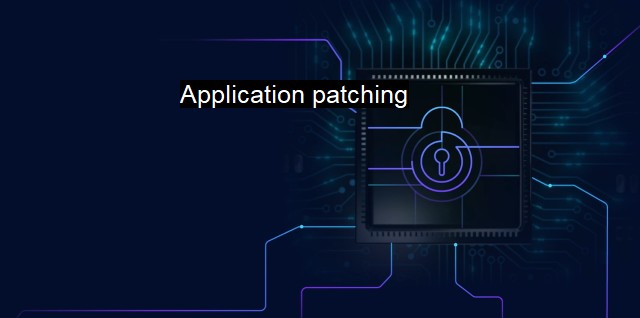What is Application patching?
Protecting Your Systems with Application Patching: Mitigating Cyber Threats and Preventing Data Breaches
In the context of cybersecurity and antivirus efforts, "application patching" plays a crucial cockpit role. It revolves around updating software applications to mend any security vulnerabilities, improving existing functionalities, or embedding new features. The small software boosters are devised to amend any defects, functioning as corrections, enhancements, or perfection tools in advancement for applications.Application patching is the frontline defense mechanism and an integral part of cybersecurity. We live in a digitized landscape where most routine transactions are performed online. The digital revolution exposes our systems to the menace of malicious software (malware) attacks, coupled with ever-evolving technology, which provides hackers with more sophisticated attack programs. They seek to exploit few or subtle vulnerabilities in your applications for access to critical data - this is where application patches come in. They eliminate system vulnerabilities and fortify them from potential exploits, thereby constructively minimizing the risk of security breaches.
Imagine systems without application patching, where users must purchase and install a new addition to a software application each time vulnerabilities are identified or new features are implemented. The inconvenience and expense generated could be overwhelming - time-consuming and disruptive to business processes. Conversely, patches offer software updates that can be made in real-time, enabling users to carry on usual computing operations relatively disruption-free.
Frequent application patching is considered beneficial and impactful as it thwarts majority malware breaches, which attempt to exploit known security vulnerabilities. In fact, various serious malware infections, such as ransomware attacks, have simply leveraged known vulnerabilities lurking in unpatched software. Stuxnet is a paramount examplar, a malicious computer worm that exploited four zero-day vulnerabilities. The prompt patching of applications minimizes this kind of exposure, thereby mitigating any similar risks of penetration and infiltration into systems.
Application patches make their way as priority focus areas to any organization leaning on information systems to operate. It showcases tremendous potential benefits for such organizations where patching software applications is synchronized automatically and connexus happen in real-time. Businesses, therefore, extract the best value from their cybersecurity initiatives with extensive patch policies which include regular scanning, fetching, executing, and validation of patch updates.
Besides mending security vulnerabilities and improving existing features, application patching also restrategizes system configuration. It updates system code, bringing more satisfactory user experience or interactive interface, thereby making an application more intuitive. It could include anything from error fixing, writing new program segments that fend off breeches or bugs, or making system amendments.
While application patches are fundamentally vital, not all such patches are created equally, and blind automatic updates may lead to other problems. Hence an institutionalized approach to systematically introducing patches, known as patch management, arises. It includes identifying, acquiring, clubbing, testing, implementing patches, and post-patch system validations to ensure stability.
In the antivirus scenario, patches closely associate as a 'vitamin pill' against malicious threats. Most antivirus software depends heavily on everyday signature updates, essentially patches to keep the software capably dealing with the newest security threats.
To sum up, application patching is a critical element in the cybersecurity and antivirus space, positioned as auto-serviceability for software applications. By regularly scuttling possessed vulnerabilities and proliferating system efficiencies, patching operates as an important gearwheel of IT maintenance, ensuring security, peak performance, and elastoplast-longevity of applications. In an era of escalating cyber threats, empowering an application with frequent patches buffers its interweaving tautness and sustains its infallible continuum.

Application patching FAQs
What is application patching?
Application patching refers to the process of updating software applications with fixes, improvements, and security patches to correct vulnerabilities and bugs. It is an essential part of cybersecurity as it helps to prevent cyberattacks and reduce the risk of security breaches.Why is application patching important for cybersecurity?
Application patching is important for cybersecurity because software vulnerabilities can be exploited by cybercriminals to gain unauthorized access to computer systems, steal sensitive data, and launch cyberattacks. Regular patching ensures that software applications are up-to-date and secure against known vulnerabilities.How often should application patching be done?
Application patching should be done as often as possible to stay up-to-date on the latest security patches and bug fixes. It is recommended to patch applications immediately when new updates become available. Patching should also be included as part of a regular cybersecurity strategy, such as weekly or monthly maintenance routines.What are the risks of not patching applications?
The risks of not patching applications include increased vulnerability to cyberattacks, data breaches, and malware infections. Without regular patching, cybercriminals can easily exploit vulnerabilities in software applications, which can lead to system compromise, data loss, and financial damage. Not patching applications can also result in compliance issues and legal repercussions if sensitive data is compromised.| | A | | | B | | | C | | | D | | | E | | | F | | | G | | | H | | | I | | | J | | | K | | | L | | | M | |
| | N | | | O | | | P | | | Q | | | R | | | S | | | T | | | U | | | V | | | W | | | X | | | Y | | | Z | |
| | 1 | | | 2 | | | 3 | | | 4 | | | 7 | | | 8 | | |||||||